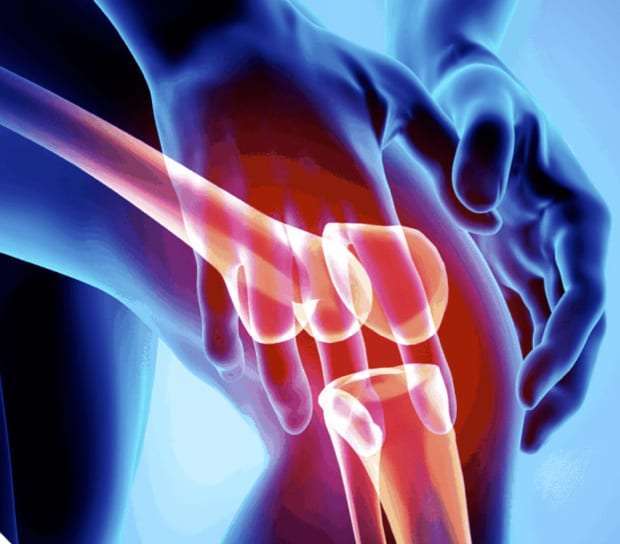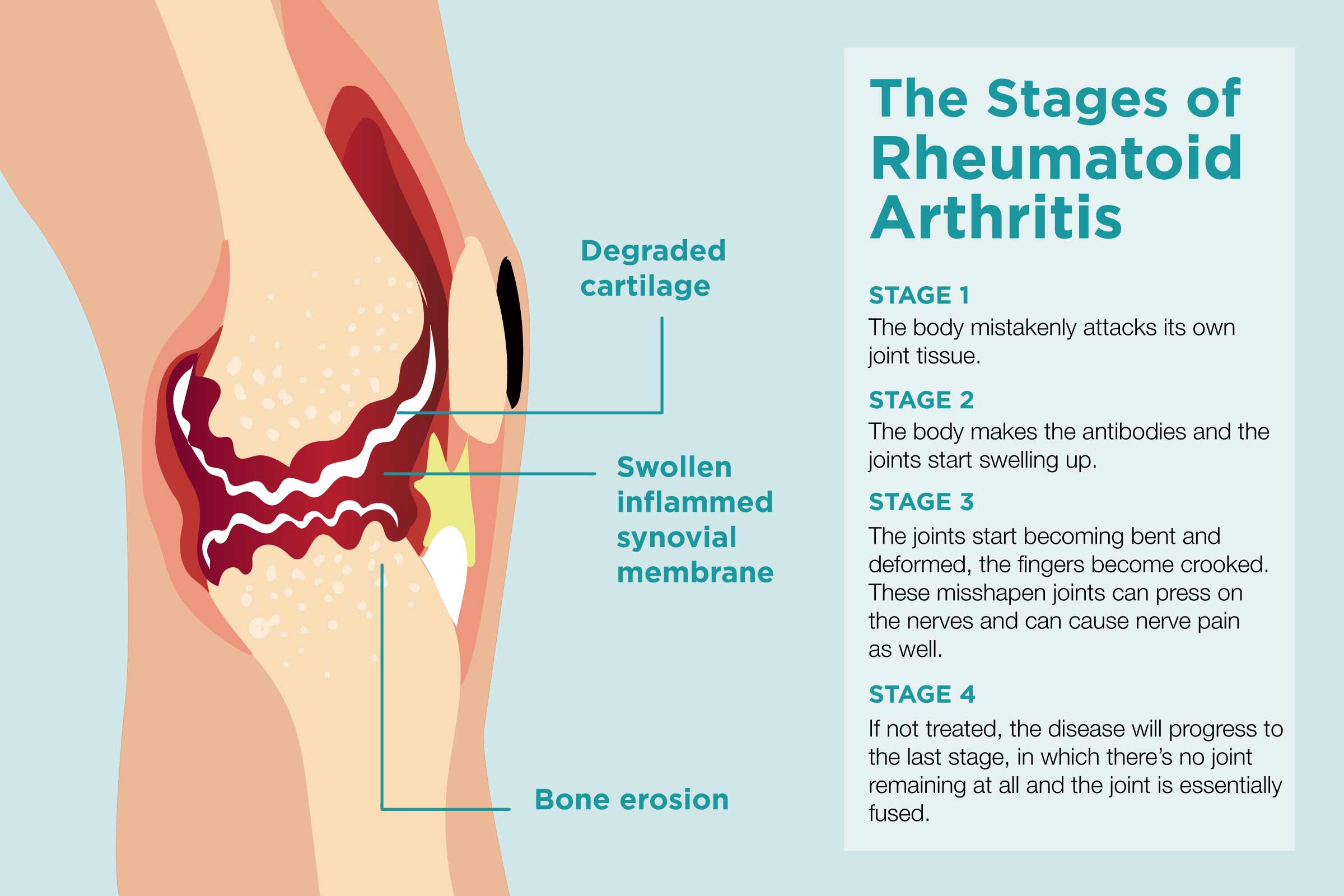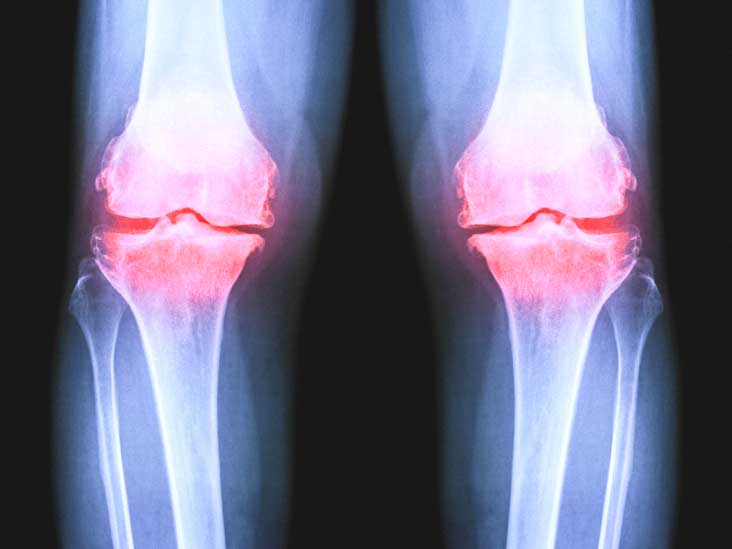What About Glucosamine And Chondroitin
Glucosamine and chondroitin are components of healthy cartilage. Both are produced naturally in the body. They are also available in supplement form.
Researchers have long studied the effects of glucosamine and chondroitin supplements on arthritis. Many studies have found mixed resultssome have shown pain relief and function improvements compared to a placebo, while others showed no benefit from using these supplements.
Because of the lack of confirmatory evidence on the effectiveness of glucosamine and chondroitin supplements, the 2019 ACR/Arthritis guidelines recommend that people with knee OA not use these supplements.
There has been little or no research on the effects of glucosamine and chondroitin supplements in people with knee arthritis related to RA.
Most supplements are generally safe to use. Talk to your healthcare provider about whether it is safe for you to start a supplement with your current knee arthritis treatment plan.
While supplements have few severe side effects attached to them, it is still possible to experience these. Supplements can also interact with prescription drugs, can make other treatments less effective, and affect other health conditions you may have.
Complementary And Alternative Therapies
Some people with osteoarthritis try complementary or alternative therapies such as acupuncture and aromatherapy and find them helpful.
However, there’s a lack of medical evidence to suggest they’re effective and they generally are not recommended by the National Institute for Health and Care Excellence .
How Is Osteoarthritis Of The Knee Diagnosed
The diagnosis of knee osteoarthritis will begin with a physical exam by your doctor. Your doctor will also take your medical history and note any symptoms. Make sure to note what makes the pain worse or better to help your doctor determine if osteoarthritis, or something else, may be causing your pain. Also find out if anyone else in your family has arthritis. Your doctor may order additional testing, including:
- X-rays, which can show bone and cartilage damage as well as the presence of bone spurs
- magnetic resonance imaging scans
MRI scans may be ordered when X-rays do not give a clear reason for joint pain or when the X-rays suggest that other types of joint tissue could be damaged. Doctors may use blood tests to rule out other conditions that could be causing the pain, such as rheumatoid arthritis, a different type of arthritis caused by a disorder in the immune system.
Don’t Miss: Does Tommie Copper Knee Sleeve Work
What Are Treatments For Knee Arthritis
Though neither category of arthritis is curable, both kinds of knee arthritis can be managed well, particularly when caught early. Thats especially true for those with inflammatory arthritis.
We know a lot more about inflammatory arthritis than we do about OA, Dr. Domingues says. And we have drugs that target the root cause of inflammatory arthritis disease-modifying antirheumatic drugs, or DMARDs which decrease inflammation, help preserve the joint, and ease pain. Biologics, a more targeted type of DMARD, may be recommended for those who dont get sufficient relief of knee pain and other symptoms from traditional DMARDs.
As for what to take for knee osteoarthritis, doctors often first recommend over-the-counter analgesics such as acetaminophen and nonsteroidal anti-inflammatory drugs , which are also sometimes used to alleviate the pain of inflammatory arthritis.
If those dont help your knee OA, steroid injections may be a good next step for managing knee joint pain, or your doctor might suggest hyaluronan injections, which provide some of the cushioning lost by cartilage breakdown in your knee joint.
But because OA is a degenerative disease, which means it will likely get worse over time, these options mostly buy you time before you may ultimately need a knee replacement, which is the definitive treatment for moderate-to-severe knee OA, Dr. Domingues says.
What Other Symptoms Are Linked With Knee Joint Pain

Symptoms of osteoarthritis of the knee are generally limited to the joint itself, whereas inflammatory arthritis causes a wider array of issues. Unlike OA, inflammatory arthritis is a systemic disease, which means it affects the whole body, says CreakyJoints Medical Advisor Vinicius Domingues, MD, a rheumatologist in Daytona Beach, Florida.
In fact, it would be less common for someone with a form of inflammatory arthritis to experience pain in just one knee. Thats because symptoms are usually symmetrical whats more, inflammatory arthritis symptoms usually dont start in the knee.
For example, rheumatoid arthritis generally strikes the small joints in the fingers and toes first, while someone with ankylosing spondylitis is more likely to complain of low back and buttock pain, with knee arthritis pain developing later.
Depending on the type of inflammatory arthritis you have, you may experience other symptoms beyond knee joint pain. People with psoriatic arthritis exhibit the telltale scaly rash and plaques of psoriasis eye inflammation can be a problem for those with psoriatic arthritis as well as ankylosing spondylitis, and people with rheumatoid arthritis may experience weight loss and fevers.
Read Also: Inversion Table Knees
What Are The Treatment Options
Overall, we manage most peoples kneecap arthritis pain with simple conservative measures. Exercise therapy should be the basis of treatment. Examples of treatments that are effective include:
- strengthening of the hip and knee
- stretching of the muscles around the hip and leg
- taping or bracing of the kneecap
- using proper shoes and orthotics
- medications such as ibuprofen
In difficult cases, we sometimes use injections to help with kneecap arthritis pain. Generally, options for injections include cortisone, hyaluronic acid, and platelet-rich plasma.
Finally, surgery should only be considered when all other treatments have failed. Moreover, joint replacement is the only effective treatment. You should avoid keyhole surgery for arthritis behind the kneecap as evidence suggests that it does not work.
Do I Have Arthritis In My Knee
Dr. Ekaterina Urch, orthopedic surgeon and knee specialist, covers the symptoms, causes, and best treatment options for knee arthritis.
What is arthritis?
Arthritis is the result of inflammation in one or more of your joints. This inflammation can cause pain, swelling, and stiffness in various joints within the body and can even lead people to replacing their joints because the arthritis has interfered with their every-day activity level. This can be particularly true with arthritis felt in the knee, one of the more common areas where arthritis can occur. Depending on how bad the pain is, it can interfere with the activities people enjoy and can keep them from pursuing an active life.
What are the different types of arthritis?
Not all types of arthritis are created equal. In fact, there are more than 100 different forms of arthritis. However, the two more common types of arthritis include osteoarthritis and rheumatoid arthritis.
Osteoarthritis
Osteoarthritis, which is known as a degenerative wear-and-tear type of arthritis, is commonly found in the knee. It is rare for osteoarthritis to be found in younger people. It is more commonly found in people 50 years of age and older.
Why is osteoarthritis causing you so much pain?
Rheumatoid arthritis
Posttraumatic arthritis
Symptoms of knee arthritis:
Other symptoms of knee arthritis:
Nonsurgical treatment for knee arthritis:
Other nonsurgical options to help ease arthritis pain:
Read Also: Whiten Knees Fast
Help For Arthritic Knees
Osteoarthritis is the most common cause of pain and disability in knees. In the knee joint, smooth articulate cartilage, called surface cartilage, covers the ends of the femur and tibia . Between the two bones sits a second type of cartilage, called menisci, which acts as a shock absorber. Joint fluid also lubricates the knee joint.
Osteoarthritis starts as the lack or loss of surface cartilage, progressively involving the surrounding bone, tissues and synovial fluid. In OA, your knee cartilage may thin in spots or disappear completely, resulting in areas of exposed bone.
X-rays, MRI and knee arthroscopy can help you and your doctor to determine the right treatment plan, which may include these noninvasive options.
How To Treat Arthritis In The Knees
This article was medically reviewed by Troy A. Miles, MD. Dr. Miles is an Orthopedic Surgeon specializing in Adult Joint Reconstruction in California. He received his MD from the Albert Einstein College of Medicine in 2010, followed by a residency at the Oregon Health & Science University and fellowship at the University of California, Davis. He is a Diplomat of the American Board of Orthopaedic Surgery and is a member of the American Association of Hip and Knee Surgeons, American Orthopaedic Association, American Association of Orthopaedic Surgery, and the North Pacific Orthopaedic Society.There are 13 references cited in this article, which can be found at the bottom of the page. This article has been viewed 63,035 times.
Research suggests that treatment may slow down arthritis and relieve your symptoms, though there’s no cure for it.XTrustworthy SourceNational Health Service Public healthcare system of the UKGo to source Arthritis occurs when your joint becomes inflamed, causing pain, stiffness, and swelling. Osteoarthritis happens when the cartilage in your joint wears away, while rheumatoid arthritis is an autoimmune condition where your body attacks your joints. Experts say arthritis in the knee is very common because it’s a weight-bearing joint, but you can get arthritis in any joint.XResearch source Although arthritis may interfere with your life, you may be able to manage your condition.
Also Check: Knees Crack When Doing Squats
What You Need To Know
- Knee arthritis occurs when the cushioning cartilage in the joint wears down, making the knee stiff and painful with certain movements.
- Osteoarthritis gradual, age-related degeneration of cartilage is the most common form of arthritis in the knee, but trauma and autoimmune conditions can also lead to cartilage damage.
- The cartilage damage associated with arthritis is irreversible, but there are nonsurgical and surgical treatments that can help reduce pain, increase joint flexibility and improve overall quality of life for people with knee arthritis.
Switch From The Sidewalk To The Treadmill
Walking or jogging on a sidewalk made of concrete can be hard on the knees. A treadmill has a little more spring and decreases the overall compressive load on the knees. When walking on a treadmill, resist the urge to walk at an incline.
Walking on a groomed earthen trail will have a similar positive effect.
You May Like: Bleach Dark Knees
Adding Or Removing Some Bone Around A Joint
If you have osteoarthritis in your knees but you’re not suitable for knee replacement surgery, you may be able to have an operation called an osteotomy. This involves your surgeon adding or removing a small section of bone either above or below your knee joint.
This helps realign your knee so your weight is no longer focused on the damaged part of your knee. An osteotomy can relieve symptoms of osteoarthritis, although you may still need knee replacement surgery eventually.
Knee Pain At A Glance

- The knee joint has three compartments.
- Causes of knee pain include injury, degeneration, arthritis, infrequently infection, and rarely bone tumors.
- Ligaments within the knee and on the inner and outer sides of the knee stabilize the joint.
- Surgical repair of ligament injury can involve suturing, grafting, and synthetic graft repair.
- Routine X-rays do not reveal meniscus tears, but can be used to exclude other problems of the bones and other tissues.
- The knee joint is commonly involved in rheumatic diseases, immune diseases that affect various tissues of the body including the joints.
Show Sources
You May Like: Inversion Table After Hip Replacement
Tendinitis Of The Knee
Tendinitis of the knee occurs in the front of the knee below the kneecap at the patellar tendon or in the back of the knee at the popliteal tendon . Tendinitis is an inflammation of the tendon, which is often produced by events, such as jumping, that strain the tendon. Patellar tendinitis, therefore, also has the name “jumper’s knee.” Tendinitis is diagnosed based on the presence of pain and tenderness localized to the tendon. It is treated with a combination of ice packs, immobilization with a knee brace as needed, rest, and anti-inflammatory medications. Gradually, exercise programs can rehabilitate the tissues in and around the involved tendon. Cortisone injections, which can be given for tendinitis elsewhere, are generally avoided in patellar tendinitis because there are reports of risk of tendon rupture as a result. In severe cases, surgery may be required. A rupture of the tendon below or above the kneecap can occur. When it does, there may be bleeding within the knee joint and extreme pain with any knee movement. Surgical repair of the ruptured tendon is often necessary.
Where Can Arthritis Occur In The Knee
Cartilage loss can occur between the thighbone and the shinbone in the medial portion , lateral portion and under the kneecap.
- Thinning of the cartilage under the kneecap is called patellofemoral arthritis .
- Some patients have cartilage loss in one, two or all of these areas. When all three areas are affected, this is called tricompartmental arthritis.
You May Like: Does Aflac Cover Hysterectomy
How To Use Pain Medications Properly
There are two types of over-the-counter pain medications that can be used for osteoarthritis. Acetaminophen is a pain reliever but not an anti-inflammatory. It may help with mild knee pain.
NSAIDs can be more effective because they both relieve pain and reduce inflammation. However, they come with potential side effects and risks. NSAIDs can irritate the lining of the stomach, which may lead to an ulcer or other stomach problems. They also can impair kidney function. Some NSAIDs can increase blood pressure. And theyve been linked to an increased risk for heart disease.
Because of the risks, Dr. Day cautions against using NSAIDs regularly over long periods of time. Instead, she uses NSAIDs for her patients in two ways. First, people who have a flare-up of pain can take them regularly for three to five days and then stop. Second, they can be used over the long term, but only occasionally, maybe a couple of times a week as needed.
If youre taking NSAIDs several times a day for long periods of time, Dr. Day advises reducing their use by maximizing the other treatment strategies. She also suggests trying a topical NSAID, such as diclofenac , which has fewer potential side effects.
Opioid pain relievers are discouraged for long-term treatment of chronic knee pain. The milder narcotic tramadol might be appropriate for occasional use in some people, says Dr. Day.
Do: Warm Up And Cool Down Before And After You Exercise
Dont jump right into your workouts if you have knee osteoarthritis, Wyss says. In general, a warm-up lubricates your joints so you’re less stiff and its easier to move, which lowers the risk of sustaining any injury during your workout. Cooling down helps you reset after exercise. A physical therapist or trainer can instruct you on the appropriate warm-up and cool-down exercises for you, he says.
Read Also: Dcf Compression Knee Sleeve
What Age Does Knee Arthritis Strike
Its possible to develop either category of knee arthritis at virtually any age. However, osteoarthritis of the knee most commonly occurs in people over age 40. Thats because its most often caused by the wear and tear that occurs in your knee joint as you age. As a result, the cartilage that cushions your knee begins to break down.
When we do see knee osteoarthritis in younger people its usually because they experienced trauma to the knee that triggered cartilage loss, says Dr. Domingues.
Certain types of inflammatory arthritis, in contrast, are more likely to develop earlier in life. Ankylosing spondylitis frequently develops between ages 20 and 40, while the age of onset of psoriatic arthritis is usually between 30 and 50.
Why Does My Knee Hurt When I Walk
For countless men and women across the country, knee pain is a daily struggle. In fact, knee pain can be so severe that some patients are unable to continue working. There are several possible causes and risk factors for chronic knee pain, including:
- Obesity
- Overuse
- Arthritis
Without a doubt, one of the most common causes of knee pain is arthritis. Patients suffering from arthritis in the knee may have either rheumatoid arthritis a condition developing in the joints lining or osteoarthritis, which is characterized by the breakdown of cartilage. While RA may occur at any point in a persons life, osteoarthritis is much more common and affects the vast majority of patients suffering from knee arthritis.
Recommended Reading: How Do I Get Rid Of Fat Around My Knees
Coping With Low Mood And Sleep Problems
You might find that osteoarthritis of the knee makes you feel depressed or anxious. Speak to your doctor if youre feeling low as they may be able to recommend psychological therapies to help you, such as cognitive behavioural therapy and stress-relieving techniques.
If your sleep is disturbed because of osteoarthritis of the knee, this could make your pain feel worse. However, there are things you can do for yourself that might help, such as:
- Keep a sleep diary to work out if there are any patterns to your sleep problems
- Sleep at regular times to get your body into a routine
- Avoid phones and other screens in the bedroom to help you wind down before bed.
If youre still having problems, speak to your doctor or an occupational therapist who can give you other tips and techniques to try, known as sleep hygiene.
Troubled By Knee Arthritis But Not Ready For Knee Replacement Here Are 5 Alternatives

Millions of Americans suffer from knee arthritis, which can cause pain, stiffness and a decrease in activity level and quality of life. Eventually, this often leads to knee replacement surgery, which remains the most effective treatment for permanent pain relief. However, knee replacement should be reserved as a last resort. There are several minimally invasive options you and your surgeon can try before committing to knee replacement surgery:
MAKING THE DECISION
Also Check: How To Use Ginger For Knee Pain